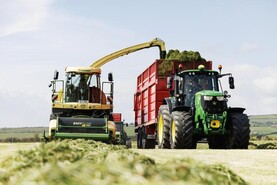It’s been a very mild winter on Tullamore Farm, as it has been on many farms around the country. This has led to phenomenal winter growth, with some paddocks closed in October recording growth of 6kg/DM/ha/day over the winter months. This would generally be in the region of 1-2kg/DM/ha/day of growth. This has meant we now have covers of 1,200-1,400kg DM/ha on the earlier-closed paddocks.
Some of the later-closed paddocks also have a good cover of grass back since November. This now means a lot of the farm has grass covers that are deemed too heavy for slurry spreading with the traditional splash plate method. While the ewes have grazed off paddocks during the winter months, this has been mostly on the heavier-type ground on the home farm so wasn’t suitable for slurry.
Tullamore options
Tanks were filling quickly and with turnout not planned for another few weeks, our only option was to spread slurry on heavier covers of grass. This meant hiring a trailing shoe slurry tanker from local contractor Healion Contractors. Brian purchased the tanker just before Christmas.
“We bought it based on customers looking for it and with an eye on the future as to what way slurry spreading will go in terms of insisting on low-emission spreading. Farmers in derogation have to spread slurry with a low-emission tanker after 1 June so we needed to be able to offer that service.”
Brian said: “We’re very happy with it [the tanker]. We went for the 2,750 gallon Conor tanker with trailing shoe fitted. Some of the negatives are that it sits out behind the tank and you need to be careful who you put up on it. The macerator can also give some trouble. Slurry needs to be well diluted with very little silage or hay through it.
“We’ve had a couple of issues with net getting into the unit which ended up having to take it apart and re-setting it. It’s also a very heavy machine with the trailing shoe fitted so it’s important that tyre size and pressure is correct. A small tip of a shed door or someone reversing back too far could prove very costly.
Slurry values
Spring application of slurry is best when the value of the nitrogen in the slurry is at its highest. When applied with a splash plate in spring, 1,000 gallons of slurry is equal to a 50kg bag of 6-5-30. When slurry is spread on cool damp days, it’s typically worth three units more N per 1,000gals of slurry as opposed to spreading it during the summer months.
Slurry applied in summer months would be the equivalent of a bag of 3-5-30 to 1,000gals. The value of phosphorus (P) and potassium (K) does not change regardless of when it’s spread and it’s a valuable fertiliser to replace P and K removed during the silage-making process.
Thick slurry applied at 3,500gals/ac will supply all the P and K maintenance requirements for a first cut. If slurry is very watery, this will also dilute the nutrients. The above values are based on a slurry dry matter of 6-8%. If this dropped to 3-4% via added water or washings, it could be halved in its nutrient value.
Trailing shoe v splash plate
Another way of increasing the N recovery from slurry is to apply with a trailing shoe, band spreader or injection. Slurry is deposited in lines behind the spreader and can incorporate into the soil quicker, meaning less chances of losses to the atmosphere. It also reduces greenhouse gas (GHG) emissions and is an area where the government is looking to target in terms of reducing our emissions from agriculture. Because it’s deposited in lines over a smaller area, odours from spreading will also be less with these spreading methods.
Verdict
There was little choice in Tullamore Farm this spring with the grass covers that we had. A trailing shoe was the only application method for us. We were very happy with the spreading, with very little grass contamination when compared to splash-plate spreading. Slurry odour was also reduced at spreading time.
The cost is high. Our contractor was spreading 2.5 loads an hour so with an extra 20 units nitrogen/hour going out with the trailing shoe at an extra cost of €15-€20/hour, it was just about covering itself. The slurry applied with the splash plate to heavy covers didn’t work.
With very little rain since application, slurry has now stuck to grass blades and will be difficult to get cattle to graze. For the option of spreading on heavy covers, it was worth it for us.






 This is a subscriber-only article
This is a subscriber-only article










SHARING OPTIONS: